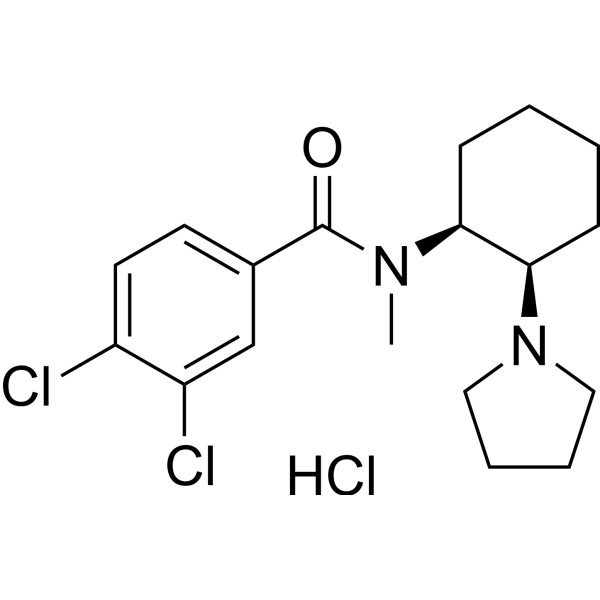
| 规格 | 价格 | |
|---|---|---|
| 500mg | ||
| 1g | ||
| Other Sizes |
| 体内研究 (In Vivo) |
在三种选定的实验性癫痫发作模型中研究了与κ阿片受体激动剂化学相关的苯甲酰胺衍生物(+-)-顺式-3,4-二氯-N-甲基-N-[2-(1-吡咯烷基)-环己基]-苯甲酰胺单盐酸盐(U-54494A)的抗惊厥活性。在小鼠最大电击发作试验中,U-54494A(ED50 28 mg/kg i.p.)有效,效力略低于苯巴比妥。结合临床使用的抗癫痫药物,特别是苯巴比妥和卡马西平,后者的抗惊厥活性显著增加。对苯巴比妥的更详细研究表明,它具有相加的抗惊厥作用。纳洛酮可部分拮抗U-54494A的抗惊厥活性。另一方面,该化合物并未提高戊四唑的癫痫发作阈值(在高剂量下,观察到促惊厥作用的趋势)。此外,在长期植入电极的无约束大鼠中,U-54494A(≥10mg/kg)显著缩短了电诱发海马后放电的持续时间。然而,局灶性刺激阈值没有显著增加。关于可能的作用方式,对培养的新生大鼠心肌细胞进行的全细胞电压钳实验表明,U-54494A以浓度和频率依赖的方式抑制了快速钠内向电流。总之,我们的研究结果与之前的报告一致,这些报告表明U-54494A在类似大发作的癫痫试验中具有明显的抗惊厥作用。此外,与一些标准的抗癫痫药物结合使用,可以发现叠加效应。有人认为,除了κ阿片样物质和兴奋性氨基酸受体相关作用外,Na+膜电流的调节可能也有助于作用机制[1]。
1.在基因易癫痫DBA/2小鼠和基因易癫痫大鼠中研究了U-54494A和U-50488H对声音引起的惊厥的影响。2.两种化合物均表现出剂量依赖性抗惊厥活性。在遗传性癫痫易感大鼠中,U-54494A作为抗惊厥药的效力不如U-50488H,而在DBA/2小鼠中,当侧脑室或腹腔内给药时,其效力与U-50488H相似。3.DBA/2小鼠在最高剂量的U-54494A和U-50488H后观察到类似的镇静和低温作用。U-50488H似乎比U-54494A表现出更大的镇静作用,对大鼠的旋转棒试验的影响要大得多。U-54494A的治疗指数优于U-50488H。4.这两种化合物的抗惊厥特性都被高剂量的纳洛酮和选择性κ阿片拮抗剂诺比萘啡亚胺拮抗。5.U-50488H和U-54494A对DBA/2小鼠的作用也被甘氨酸/NDA受体拮抗剂D-丝氨酸拮抗。6.目前的结果表明,在癫痫现象中,κ阿片样物质和甘氨酸/NDA受体之间可能存在相互作用。[2] |
|---|---|
| 动物实验 |
1. The effects of U-54494A and U-50488H on convulsions produced by sound have been studied in genetically epilepsy-prone DBA/2 mice and genetically epilepsy-prone rats. 2. Both compounds showed a dose-dependent anticonvulsant activity. U-54494A was less potent as an anticonvulsant than U-50488H in genetically epilepsy-prone rats and elicited a similar potency to that of U-50488H in DBA/2 mice when administered intracerebroventricularly or intraperitoneally. 3. Similar sedative and hypothermic effects were observed after the highest dose of U-54494A and U-50488H in DBA/2 mice. U-50488H seems to exhibit a greater sedative effect and to affect the rotarod test in rats much more than U-54494A. U-54494A elicited a better therapeutic index than U-50488H. 4. The anticonvulsant properties of both compounds are antagonized by high doses of naloxone and nor-binaltorphimine, a selective kappa-opioid antagonist. 5. The effects of U-50488H and U-54494A in DBA/2 mice were also antagonized by the glycine/NMDA receptor antagonist D-serine. 6. The present results suggest a possible interaction between kappa-opioid and the glycine/NMDA receptors during epileptic phenomena.[2]
|
| 药代性质 (ADME/PK) |
U-54494A, a racemic mixture of two enantiomers, is being developed in racemic form as an anticonvulsant drug candidate. A comparative pharmacokinetic study with intravenous and oral administration of the two individual enantiomers to the dog was conducted to evaluate the potential enantioselective pharmacokinetics of U-54494. Following i.v. administration, the (-)- and (+)-enantiomers showed no significant differences in plasma clearance (0.84 +/- 0.11 versus 0.86 +/- 0.06 l/hr/kg) and terminal elimination half-life (11.2 +/- 2.7 versus 8.0 +/- 2.6 hr) for the parent drug. However, the AUC of intact drug was two-fold lower with two-fold shorter elimination half-life following the oral administration for the (+)-enantiomer as compared to the (-)-enantiomer. Higher plasma levels of the four metabolites were also observed for the (+)-than for the (-)-enantiomer, particularly after oral administration. These results suggested that the (+)-enantiomer appeared to be more extensively metabolized by first-pass effect than the (-)-enantiomer after oral dosing, and as a result, oral bioavailability for the (+)-enantiomer is only one half of that for its antipode (12.0 +/- 1.5% versus 26 +/- 9%). Enantiomer. 1996;1(2):89-96. https://pubmed.ncbi.nlm.nih.gov/9676281/
|
| 参考文献 |
|
| 其他信息 |
See also: U 54494A (annotation moved to).
|
| 分子式 |
C18H25CL3N2O
|
|---|---|
| 分子量 |
391.76
|
| 精确质量 |
390.103
|
| CAS号 |
112465-94-8
|
| PubChem CID |
183469
|
| 外观&性状 |
Typically exists as solid at room temperature
|
| 沸点 |
496.5ºC at 760 mmHg
|
| 闪点 |
254.1ºC
|
| 蒸汽压 |
5.38E-10mmHg at 25°C
|
| LogP |
5.212
|
| tPSA |
23.55
|
| 氢键供体(HBD)数目 |
1
|
| 氢键受体(HBA)数目 |
2
|
| 可旋转键数目(RBC) |
3
|
| 重原子数目 |
24
|
| 分子复杂度/Complexity |
414
|
| 定义原子立体中心数目 |
2
|
| SMILES |
Cl.ClC1C=CC(C(N(C2CCCCC2N2CCCC2)C)=O)=CC=1Cl
|
| InChi Key |
WFUASZXAHZXJMX-PPPUBMIESA-N
|
| InChi Code |
InChI=1S/C18H24Cl2N2O.ClH/c1-21(18(23)13-8-9-14(19)15(20)12-13)16-6-2-3-7-17(16)22-10-4-5-11-22;/h8-9,12,16-17H,2-7,10-11H2,1H3;1H/t16-,17+;/m1./s1
|
| 化学名 |
3,4-dichloro-N-methyl-N-[(1R,2S)-2-pyrrolidin-1-ylcyclohexyl]benzamide;hydrochloride
|
| 别名 |
112465-94-8; U-54494A HYDROCHLORIDE; U-54494ahydrochloride; cis-3,4-Dichloro-N-methyl-N-(2-(1-pyrrolidinyl)cyclohexyl)benzamide monohydrochloride; 2BZ8ZBR9LF; 3,4-dichloro-N-methyl-N-[(1R,2S)-2-pyrrolidin-1-ylcyclohexyl]benzamide;hydrochloride; U 54494A; UNII-2BZ8ZBR9LF;
|
| HS Tariff Code |
2934.99.9001
|
| 存储方式 |
Powder -20°C 3 years 4°C 2 years In solvent -80°C 6 months -20°C 1 month |
| 运输条件 |
Room temperature (This product is stable at ambient temperature for a few days during ordinary shipping and time spent in Customs)
|
| 溶解度 (体外实验) |
May dissolve in DMSO (in most cases), if not, try other solvents such as H2O, Ethanol, or DMF with a minute amount of products to avoid loss of samples
|
|---|---|
| 溶解度 (体内实验) |
注意: 如下所列的是一些常用的体内动物实验溶解配方,主要用于溶解难溶或不溶于水的产品(水溶度<1 mg/mL)。 建议您先取少量样品进行尝试,如该配方可行,再根据实验需求增加样品量。
注射用配方
注射用配方1: DMSO : Tween 80: Saline = 10 : 5 : 85 (如: 100 μL DMSO → 50 μL Tween 80 → 850 μL Saline)(IP/IV/IM/SC等) *生理盐水/Saline的制备:将0.9g氯化钠/NaCl溶解在100 mL ddH ₂ O中,得到澄清溶液。 注射用配方 2: DMSO : PEG300 :Tween 80 : Saline = 10 : 40 : 5 : 45 (如: 100 μL DMSO → 400 μL PEG300 → 50 μL Tween 80 → 450 μL Saline) 注射用配方 3: DMSO : Corn oil = 10 : 90 (如: 100 μL DMSO → 900 μL Corn oil) 示例: 以注射用配方 3 (DMSO : Corn oil = 10 : 90) 为例说明, 如果要配制 1 mL 2.5 mg/mL的工作液, 您可以取 100 μL 25 mg/mL 澄清的 DMSO 储备液,加到 900 μL Corn oil/玉米油中, 混合均匀。 View More
注射用配方 4: DMSO : 20% SBE-β-CD in Saline = 10 : 90 [如:100 μL DMSO → 900 μL (20% SBE-β-CD in Saline)] 口服配方
口服配方 1: 悬浮于0.5% CMC Na (羧甲基纤维素钠) 口服配方 2: 悬浮于0.5% Carboxymethyl cellulose (羧甲基纤维素) 示例: 以口服配方 1 (悬浮于 0.5% CMC Na)为例说明, 如果要配制 100 mL 2.5 mg/mL 的工作液, 您可以先取0.5g CMC Na并将其溶解于100mL ddH2O中,得到0.5%CMC-Na澄清溶液;然后将250 mg待测化合物加到100 mL前述 0.5%CMC Na溶液中,得到悬浮液。 View More
口服配方 3: 溶解于 PEG400 (聚乙二醇400) 请根据您的实验动物和给药方式选择适当的溶解配方/方案: 1、请先配制澄清的储备液(如:用DMSO配置50 或 100 mg/mL母液(储备液)); 2、取适量母液,按从左到右的顺序依次添加助溶剂,澄清后再加入下一助溶剂。以 下列配方为例说明 (注意此配方只用于说明,并不一定代表此产品 的实际溶解配方): 10% DMSO → 40% PEG300 → 5% Tween-80 → 45% ddH2O (或 saline); 假设最终工作液的体积为 1 mL, 浓度为5 mg/mL: 取 100 μL 50 mg/mL 的澄清 DMSO 储备液加到 400 μL PEG300 中,混合均匀/澄清;向上述体系中加入50 μL Tween-80,混合均匀/澄清;然后继续加入450 μL ddH2O (或 saline)定容至 1 mL; 3、溶剂前显示的百分比是指该溶剂在最终溶液/工作液中的体积所占比例; 4、 如产品在配制过程中出现沉淀/析出,可通过加热(≤50℃)或超声的方式助溶; 5、为保证最佳实验结果,工作液请现配现用! 6、如不确定怎么将母液配置成体内动物实验的工作液,请查看说明书或联系我们; 7、 以上所有助溶剂都可在 Invivochem.cn网站购买。 |
| 制备储备液 | 1 mg | 5 mg | 10 mg | |
| 1 mM | 2.5526 mL | 12.7629 mL | 25.5258 mL | |
| 5 mM | 0.5105 mL | 2.5526 mL | 5.1052 mL | |
| 10 mM | 0.2553 mL | 1.2763 mL | 2.5526 mL |
1、根据实验需要选择合适的溶剂配制储备液 (母液):对于大多数产品,InvivoChem推荐用DMSO配置母液 (比如:5、10、20mM或者10、20、50 mg/mL浓度),个别水溶性高的产品可直接溶于水。产品在DMSO 、水或其他溶剂中的具体溶解度详见上”溶解度 (体外)”部分;
2、如果您找不到您想要的溶解度信息,或者很难将产品溶解在溶液中,请联系我们;
3、建议使用下列计算器进行相关计算(摩尔浓度计算器、稀释计算器、分子量计算器、重组计算器等);
4、母液配好之后,将其分装到常规用量,并储存在-20°C或-80°C,尽量减少反复冻融循环。
计算结果:
工作液浓度: mg/mL;
DMSO母液配制方法: mg 药物溶于 μL DMSO溶液(母液浓度 mg/mL)。如该浓度超过该批次药物DMSO溶解度,请首先与我们联系。
体内配方配制方法:取 μL DMSO母液,加入 μL PEG300,混匀澄清后加入μL Tween 80,混匀澄清后加入 μL ddH2O,混匀澄清。
(1) 请确保溶液澄清之后,再加入下一种溶剂 (助溶剂) 。可利用涡旋、超声或水浴加热等方法助溶;
(2) 一定要按顺序加入溶剂 (助溶剂) 。